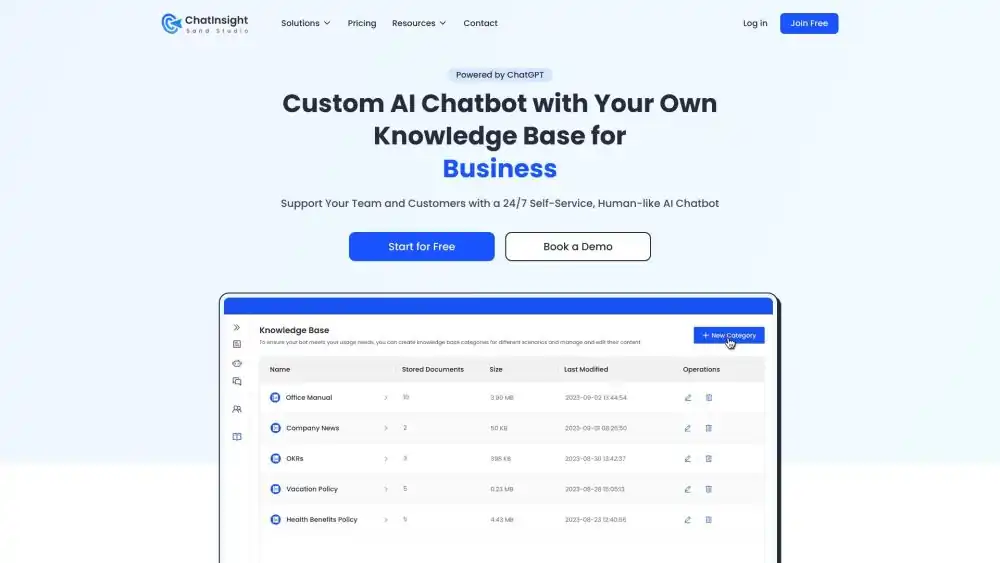Introduction: ChatInsight
ChatInsight is a cutting-edge platform designed to empower businesses in harnessing the full potential of their conversational data. By providing in-depth analytics, actionable insights, and powerful tools, ChatInsight helps organizations understand customer behavior, optimize customer interactions, and drive business growth.
With ChatInsight, businesses can gain valuable insights into customer sentiment, preferences, and pain points. By analyzing chat conversations, our platform helps identify trends, uncover opportunities, and measure the effectiveness of customer support teams.
Whether you’re looking to improve customer satisfaction, increase sales, or enhance your overall customer experience, ChatInsight is your trusted partner.
Pros and Cons of ChatInsight
Pros
- Data-driven insights: Provides valuable insights into customer behavior and preferences.
- Improved customer satisfaction: Helps identify areas for improvement in customer service.
- Increased efficiency: Automates tasks and streamlines workflows.
- Better resource allocation: Optimizes staffing based on customer demand.
- Competitive advantage: Offers a unique selling point compared to competitors.
Cons
- Data privacy concerns: Handling sensitive customer data requires robust security measures.
- Implementation challenges: Integrating with existing systems may require technical expertise.
- Dependency on data quality: The accuracy of insights depends on the quality of the data collected.
- Cost: Implementing and maintaining ChatInsight may involve significant investment.
- Learning curve: Users may require training to effectively utilize the platform’s features.
By understanding both the advantages and disadvantages of ChatInsight, businesses can make informed decisions about whether it’s the right tool for their needs.
Would you like to explore specific use cases for ChatInsight?
Pricing for ChatInsight
ChatInsight’s pricing strategy will likely depend on several factors:
- Target market: The size and industry of businesses using the platform.
- Feature set: The complexity and depth of analytics offered.
- Data volume: The amount of chat data processed.
- Competitive landscape: Pricing of similar platforms.
Potential Pricing Models
Here are some possible pricing models for ChatInsight:
- Tiered pricing: Offer different pricing plans based on features, user numbers, or data volume.
- Per-user pricing: Charge based on the number of users accessing the platform.
- Usage-based pricing: Charge based on the amount of data processed or analyzed.
- Hybrid pricing: Combine subscription-based and usage-based pricing.
Example Pricing Structure
Tiered Subscription-Based Pricing:
| Plan | Features | Price |
|---|---|---|
| Basic | Core analytics, limited users, basic support | $X/month |
| Standard | Advanced analytics, increased user limit, priority support | $Y/month |
| Enterprise | Comprehensive analytics, unlimited users, dedicated account manager | $Z/month |
Additional Considerations:
- Free trial or freemium model: Offer a free version or trial to attract potential customers.
- Custom pricing: Provide tailored pricing packages for large enterprise clients.
- Discounts: Offer discounts for annual subscriptions or referrals.
- Contract terms: Determine contract lengths and renewal options.
By carefully considering these factors and experimenting with different pricing models, ChatInsight can find the optimal pricing strategy that maximizes revenue and customer satisfaction.
Would you like to explore a specific pricing model or discuss your target market in more detail?
ChatInsight Alternatives
Here are some popular alternatives to ChatInsight that offer similar functionalities for analyzing customer conversations:
Dedicated Conversation Analytics Platforms
- Medallia: (https://www.medallia.com/)
- Offers a comprehensive platform for customer experience management, including conversation analytics.
- Qualtrics: (https://www.qualtrics.com/)
- Provides a wide range of survey and experience management tools, including conversation analysis.
- InMoment: (https://inmoment.com/)
- Focuses on customer experience and offers conversation analytics as a key feature.
Customer Support Platforms with Analytics
- Zendesk: (https://www.zendesk.com/)
- Offers customer support software with built-in analytics and reporting.
- Freshdesk: (https://www.freshworks.com/freshdesk/)
- Provides a cloud-based customer support platform with conversation analytics.
- Intercom: (https://www.intercom.com/)
- Focuses on customer messaging and engagement, with analytics capabilities.
Business Intelligence and Analytics Platforms
- Tableau: (https://www.tableau.com/)
- Offers data visualization and analytics tools that can be used for conversation analysis.
- Power BI: (https://powerbi.microsoft.com/)
- Microsoft’s business intelligence platform can be used to analyze customer conversations.
It’s important to compare these alternatives based on your specific needs and budget. Consider factors such as features, pricing, ease of use, and integration capabilities when making a decision.
Would you like to explore any of these options further or discuss specific features you’re looking for?
FAQs: Your Go-To Information Hub
FAQs, short for Frequently Asked Questions, are a collection of questions and their answers designed to provide quick and easy information to users. They’re commonly found on websites, but can also be used in other formats like emails or documents.
Why Use FAQs?
- Saves time: Users can find answers without contacting support.
- Improves customer satisfaction: Quick resolutions to common issues.
- Reduces support load: Fewer repetitive inquiries.
- Boosts SEO: Well-structured FAQs can improve search engine rankings.
Creating Effective FAQs
- Identify common questions: Analyze customer interactions and support tickets.
- Write clear and concise answers: Use simple language and avoid technical jargon.
- Organize questions logically: Categorize by topic for easy navigation.
- Keep it updated: Regularly review and update FAQs as needed.
Example FAQ Structure
- Introduction: Briefly explain the purpose of the FAQs.
- Question and Answer sections: Clear and concise format.
- Search function: Allow users to search for specific questions.
- Contact information: Provide options for further assistance.
Would you like to create FAQs for a specific product, service, or topic? I can help you brainstorm questions, write answers, or structure your FAQ page.
Conclusion: The Final Chapter
A conclusion is the final part of something, where you wrap up the main points and provide a sense of closure.
Key Elements of a Strong Conclusion
- Summarize main points: Briefly reiterate the key arguments or ideas presented.
- Restate thesis (if applicable): Reinforce the main claim of your work.
- Offer final thoughts or insights: Provide additional perspectives or implications.
- Call to action (optional): Encourage readers to take specific steps.
Examples of Conclusions
- Essay: Summarizes the main arguments and offers a final thought on the topic.
- Speech: Reinforces the key message and leaves the audience with a memorable takeaway.
- Research paper: Restates the thesis, summarizes findings, and suggests areas for further research.
- Story: Provides a sense of closure and resolution for the characters and plot.
Would you like to work on a conclusion for a specific piece of writing? I can help you craft a strong and effective ending.
![]()






